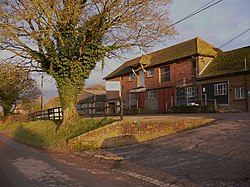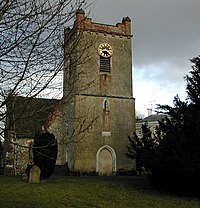Newton Valence
| Newton Valence | |
| Hampshire | |
|---|---|
 Farm in Newton Valence Farm | |
| Location | |
| Grid reference: | SU723326 |
| Location: | 51°5’20"N, 0°58’7"W |
| Data | |
| Population: | 226 (2011) |
| Post town: | Alton |
| Postcode: | GU34 |
| Local Government | |
| Council: | East Hampshire |
| Parliamentary constituency: |
East Hampshire |
Newton Valence is a village in Hampshire, four and a half miles south of Alton, just off the A32 road.
The village sits high in the westernmost chalk hills of the South Downs.
Farming is the most obvious economic activity. Arable farming (mainly wheat, maize and oil-seed rape) and sheep-grazing predominate.
Contents
The church and grounds
The Church of St Mary was restored in 1871 and is faced in flint. The nave and chancel are of Early English Gothic style, from about 1300; the west tower is also Early English, but has an embattled top, made of brick and dated to 1812.[1] There are five bells in the tower, the largest weighing nine hundredweight. The tower's black-faced clock was restored as a Millennium Project. There are two piscinas and a large Norman font.
Charles Wilson, 1st Baron Moran, Sir Winston Churchill's personal physician, is buried in the churchyard.
The yew tree next to the church is one of the most venerable in the district now that the famous yew at Selborne Church has died. Its age has been estimated at about 1,000 years.[2]
Adjoining the churchyard is the Manor House (17th–18th Century), now divided into two dwellings. The older portion has two storeys of coursed stone blocks with brick dressings, plinth and band, and a long ridge slate roof. There is a red brick Georgian portion, with parapet and hipped tile roof. The Victorian wing, of yellow brick, is of two storeys with a low pitched slate roof and sash windows.
History
There are traces of prehistoric settlement here: a Bronze Age bowl barrow: 120 feet in diameter and 6 feet high (north-east of Lodge Farm) and an Iron Age field system at the southern edge of Goldridge Plantation, comprising a series of three contour lynchets extending for a mile.
The enclosure of the commons and common fields of Newton Valence was authorised in 1848 in the Second Enclosure Act of that year along with fifteen other disparate places, with only Greatham also in Hampshire. A local professional land surveyor and valuer was employed. Richard Wakefield Attree of Bishearne in the parish of Liss, whose report allotted almost 150 acres among nine groups consisting of eleven people, with a further six acres specified for roads and a pond,[3] [4] the latter to be a ‘public watering place’ at Upper Common. The pond can be seen today at Headmore Farm on Headmore Lane in what was the furthest point in Newton Valence from the village centre.
Two fenced acres were allotted to the churchwardens and overseers of the poor in trust ‘as a place of exercise and recreation for the inhabitants … of the neighbourhood’.[5]
The village features in Gilbert White's Natural History of Selborne.[6] White's brother, John, used to live in Newton Valence. Gilbert would cross Selborne Common to visit him: a walk of about two miles, made easier in 1753 when they finished construction of the Zig-Zag path which, ascending from Selborne to the Common, is still in use today.
About the viullage
Opposite the driveway to the church is a dew pond which was repuddled in the 1990s. Nearby, on a triangle of grass between Newton Lane and the track to Selborne Common, is a small sarsen stone.
Within the parish boundary is Noar Hill, part of which is given over to a nature reserve noted for its flowers and butterflies.
Society
The village has a Sports and Social Centre (half of the Victorian school; the other half has been converted to a dwelling), but no shops or public house.
Outside links
| ("Wikimedia Commons" has material about Newton Valence) |
References
- ↑ Quotation from Pevsner's Buildings of England
- ↑ Mr T. P. Denehy, Tree Warden, personal comment on the age of the churchyard yew
- ↑ Heal, Ropley's Legacy, Chapter 10 with two maps and Appendix 23 with transcription
- ↑ HRO, Q23/2/94 (with map). Chapman and Seeliger, Guide to Enclosure, p. 115,
- ↑ The National Archives, MAF 1/543.
- ↑ The Natural History of Selborne by Gilbert White
- Heal, Chris: 'Ropley's Legacy, The ridge enclosures, 1709 to 1850: Chawton, Farringdon, Medstead, Newton Valence and Ropley and the birth of Four Marks' (Chattaway & Spottiswood, 2021)
